The Accumulation/Distribution Line is interpreted by looking for a divergence in the direction of the indicator relative to price. If the Accumulation/Distribution Line is trending upward it indicates that the price may follow. Also, if the Accumulation/Distribution Line becomes flat while the price is still rising (or falling) then it signals an impending flattening of the price.
The Accumulation/Distribution Line was developed by Marc Chaikin.
The Accumulation/Distribution Line should not be confused with the Williams Price Accumulation/Distribution indicator.

The Accumulation Swing Index was developed by J. Welles Wilder and is described in his 1978 book New Concepts In Technical Trading Systems.


See also +/-DI, DX and ADXR.
The ADX was developed by J. Welles Wilder and is described in his 1978 book New Concepts In Technical Trading Systems.

See also +/-DI, DX and ADX.
The ADXR was developed by J. Welles Wilder and is described in his 1978 book New Concepts In Technical Trading Systems.

The volume is divided by a volume increment (typically 10,000) to make the resultant numbers larger and easier to work with. The EMV is usually smoothed with a moving average.
The Arms Ease of Movement indicator was developed by Richard W. Arms, Jr. See also Arms Index (TRIN).

When the Aroon Up is staying between 70 and 100 then it indicates an upward trend. When the Aroon Down is staying between 70 and 100 then it indicates an downward trend. A strong upward trend is indicated when the Aroon Up is above 70 while the Aroon Down is below 30. Likewise, a strong downward trend is indicated when the Aroon Down is above 70 while the Aroon Up is below 30. Also look for crossovers. When the Aroon Down crosses above the Aroon Up, it indicates a weakening of the upward trend (and vice versa).
The Aroon indicator was developed by Tushar S. Chande and first described in the September 1995 issue of Technical Analysis of Stocks & Commodities magazine.

The Aroon indicator was developed by Tushar S. Chande and first described in the September 1995 issue of Technical Analysis of Stocks & Commodities magazine.

The ATR is a component of the Welles Wilder Directional Movement indicators (+/-DI, DX, ADX and ADXR).
The ATR was developed by J. Welles Wilder and is described in his 1978 book New Concepts In Technical Trading Systems.

Bollinger Bands do not, in themselves, generate buy or sell signals: they are an indicator of overbought or oversold conditions. When the price is near the upper or lower band it indicates that a reversal may be imminent. The middle band becomes a support or resistance level. The upper and lower bands can also be interpreted as price targets. When the price bounces off of the lower band and crosses the middle band, then the upper band becomes the price target.
See also Bollinger Width, Envelope, Price Channels and Projection Bands.
Bollinger Bands were developed by John Bollinger.

See also Bollinger Bands.
Bollinger Bands were developed by John Bollinger.

The Commodity Channel Index was developed by Donald Lambert and is described in his article in the October 1980 issue of Commodities magazine (now called Futures).


When the Chaikin Money Flow is above 0.25 it is a bullish signal, when it is below -0.25, it is a bearish signal. If the Chaikin Money Flow remains below zero while the price is rising, it indicates a probable reversal.
The Chaikin Money Flow indicator was developed by Marc Chaikin.

The Chaikin Oscillator was developed by Marc Chaikin.

The Chaikin Volatility indicator was developed by Marc Chaikin.

There are several ways to interpret the CMO. Values over 50 indicate overbought conditions, while values under -50 indicate oversold conditions. High CMO values indicate strong trends. When the CMO crosses above a moving average of the CMO, it is a buy signal, crossing down is a sell signal.
The Chande Momentum Oscillator was developed by Tushar S. Chande and is described in the 1994 book The New Technical Trader by Tushar S. Chande and Stanley Kroll.

The Commodity Selection Index was developed by J. Welles Wilder and is described in his 1978 book New Concepts In Technical Trading Systems.

The DEMA was developed by Patrick Mulloy and is described in his article in the February, 1994 issue of Technical Analysis of Stocks & Commodities magazine.
See also Exponential Moving Average, TEMA and T3.

The Demand Index can be interpreted by looking for divergence with price to indicate impending price moves. Peaks in the Demand Index signal a coming peak in price. When the Demand Index hovers around zero, it indicates weak price moves.
The Demand Index was developed by James Sibbet.


Note that the calculation shifts the results (shift = term / 2 + 1) periods, so the last shift periods will be zero. The size property of the output array is set accordingly, and the last shift periods will not be graphed.

See also DX, ADX and ADXR.
The DI was developed by J. Welles Wilder and is described in his 1978 book New Concepts In Technical Trading Systems.

See also +/-DI, ADX and ADXR.
The DX was developed by J. Welles Wilder and is described in his 1978 book New Concepts In Technical Trading Systems.


See also RSI.
The Dynamic Momentum Index was developed by Tushar S. Chande and Stanley Kroll and is described in their 1994 book The New Technical Trader.

See also Envelolpe, Bollinger Bands, Price Channels and Projection Bands.

See also Least Squares MA, Simple MA, Triangular MA, Weighted MA, Welles MA, Variable MA, Volume Adjusted MA, Zero Lag Exponential MA, DEMA, TEMA and T3.

The Herrick Payoff Index was developed by John Herrick.

The Senkou Spans are support and resistance lines. When the price is in the Cloud, the market is non-trending. When the price is above the Cloud, the higher Span is the first support level and the lower Span is the second support level. When the price is below the Cloud, the lower Span is the first resistance level and the higher Span is the second resistance level.
Kijun-sen and Tenkan-sen are trend indicators. When the price is above the Kijun-sen, prices will likely continue to go up, when the price is below the Kijun-sen, prices will likely continue to go down. The direction of the Tenkan-sen indicates the direction of the trend. If the Tenkan-sen is flat, the market is in a non-trending channel.
A buy signal is generated when the Chinkou Span crosses over the price, or when the Tenkan-sen crosses over the Kijun-sen. A sell signal is generated when the Chinkou Span crosses under the price, or when the Tenkan-sen crosses under the Kijun-sen. Look for confirmation when both crosses occur.
The Ichimoku Kinko Hyo was developed by Goichi Hosoda before WWII, and published in 1969.

The Intraday Momentum Index was developed by Tushar S. Chande and Stanley Kroll and is described in their 1994 book The New Technical Trader.

The Inertia indicator was developed by Donald Dorsey and was introduced his article in September, 1995 issue of Technical Analysis of Stocks & Commodities magazine.

To interpret the KO, look for divergence with the price to signal the coming end of a trend, or to indicate that rising/falling prices are not forming a new trend. A buy signal is generated when the KO rises from below zero to cross above the trigger line. A sell signal is generated when the KO falls from its high and crosses below the trigger line.
The Klinger Oscillator is also known as the Klinger Volume Oscillator or KVO.
The Klinger Oscillator was developed by Stephen J. Klinger and was first presented in his article in the Winter 1994/Spring 1995 issue of MTA Journal.

The Least Squares Moving Average is also known as an Endpoint Moving Average, a Time Series Moving Average or a Time Series Forecast.
See also Exponential MA, Simple MA, Triangular MA, Weighted MA, Welles MA, Variable MA, Volume Adjusted MA, Zero Lag Exponential MA, DEMA, TEMA and T3.

The MASS Index was developed by Donald Dorsey and was presented in his article in the June, 1992 issue of Technical Analysis of Stocks & Commodities magazine.

The Mesa Sine Wave was developed by John Elhers and was introduced in his article in the November, 1996 issue of Technical Analysis of Stocks & Commodities magazine.

To interpret the MFI, compare it to the volume. When the MFI is high and volume is low, it signals a fake trend which will soon reverse. When the MFI is low and volume is high, it signals a new trend in either direction is about to occur. When the MFI is low and volume is also low, it signals a fading market and an impending trend reversal. When the MFI is high and volume is also high, it signals a strong trend.
The Market Facilitation Index was developed by Dr. Bill Williams and is described in his 1995 book, Trading Chaos.




The MACD signals trend changes and indicates the start of new trend direction. High values indicate overbought conditions, low values indicate oversold conditions. Divergence with the price indicates an end to the current trend, especially if the MACD is at extreme high or low values. When the MACD line crosses above the signal line a buy signal is generated. When the MACD crosses below the signal line a sell signal is generated. To confirm the signal, the MACD should be above zero for a buy, and below zero for a sell.
The time periods for the MACD are often given as 26 and 12. However the function actually uses exponential constants of 0.075 and 0.15, which are closer to 25.6667 and 12.3333 periods. To create a similar indicator with time periods other than those built into the MACD, use the Price Oscillator function.
The MACD was developed by Gerald Appel.








The Net Momentum Oscillator was developed by Tushar Chande and Stanley Kroll and was introduced in their article in the May, 1993 issue of Technical Analysis of Stocks & Commodities magazine.

Also see the Positive Volume Index.
The Negative and Positive Volume Index were developed by Norman Fosback and are described in his 1976 book, Stock Market Logic.


To interpret the OBV, look for the OBV to move with the price or precede price moves. If the price moves before the OBV, then it is a non-confirmed move. A series of rising peaks, or falling troughs, in the OBV indicates a strong trend. If the OBV is flat, then the market is not trending.
The On Balance Volume was developed by Joseph Granville and is described in his 1963 book, New Strategy of Daily Stock Market Timing for Maximum Profit.

Also see On Balance Volume and On Balance Volume, Moving.

See On Balance Volume for more information. Also see On Balance Volume, Expanded System.
The Oscillator function calculates the difference between two data series. It is a generic function that can take any price or indicator data as input. It is used in the calculation of many indicators.

The Parabolic SAR was developed by J. Welles Wilder and is described in his 1978 book, New Concepts In Technical Trading Systems.


Also see the Negative Volume Index.
The Positive and Negative Volume Index were developed by Norman Fosback and are described in his 1976 book, Stock Market Logic.

PVO crosses over zero when the fast Exponential Moving Average (EMA) is greater than the slow EMA indicating that volume is above average. The PVO crosses below zero when the fast EMA is less than the slow EMA indicating that volume is below average. The direction of the PVO curve indicates rising or falling volume levels. Look for strong volume (rising PVO) to confirm price trends. A moving average of the PVO can be used as a signal line to indicate longer term movements and to look for crossovers.

The Polarized Fractal Efficiency indicator was developed by Hans Hannula and was introduced in the January, 1994 issue of Technical Analysis of Stocks & Commodities magazine.
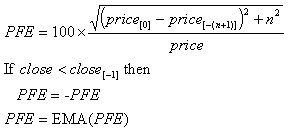
The Price Volume Rank was developed by Anthony J. Macek and is described in his article in the June, 19994 issue of Technical Analysis of Stocks & Commodities magazine.

See also On Balance Volume.

See also Bollinger Bands, Envelope and Projection Bands.

See also Price Oscillator Percent, MACD.

See also Price Oscillator.

See also Projection Bandwidth and Projection Oscillator. For other types of bands, see Bollinger Bands, Envelope and Price Channels.
Projection Bands were developed by Mel Widner, Ph.D and were originally introduced in his article in the July, 1995 issue of Technical Analysis of Stocks & Commodities magazine.

See also Projection Bands and Projection Oscillator.
Projection Bands were developed by Mel Widner, Ph.D and were originally introduced in his article in the July, 1995 issue of Technical Analysis of Stocks & Commodities magazine.

The Projection Oscillator can be interpreted several ways. Look for divergence with price to indicate a trend reversal. Extreme values (over 80 or under 20) indicate overbought/oversold levels. A moving average of the oscillator can be used as a trigger line. A buy/sell signal is generated when the Projection Oscillator to cross above/below the trigger line. The signal is stronger if it happens above 70 or below 30.
See also Projection Bands and Projection Bandwidth.
Projection Bands were developed by Mel Widner, Ph.D and were originally introduced in his article in the July, 1995 issue of Technical Analysis of Stocks & Commodities magazine.

To interpret the Qstick, look for a buy signal when it crosses above zero, and a sell signal when it crosses below zero. Also look for a buy signal when the Qstick is very low and turns up, and a sell signal when it is very high and turns down. A moving average of the Qstick can be used as a trigger line (look for the Qstick to cross the trigger). You can also look for divergence between the Qstick and price to indicate the end of a trend or as a non-confirmation of a price move.
The Qstick indicator was developed by Tushar S. Chande and Stanley Kroll and is described in their 1994 book The New Technical Trader.

The Range Indicator was developed by Jack Weinberg and was introduced in his article in the June, 1995 issue of Technical Analysis of Stocks & Commodities magazine.
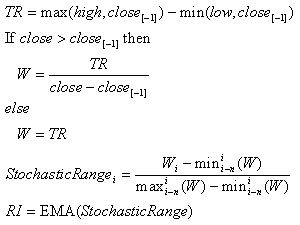

See also Relative Strength Index.
The Relative Momentum Index was developed by Roger Altman and was introduced in his article in the February, 1993 issue of Technical Analysis of Stocks & Commodities magazine.
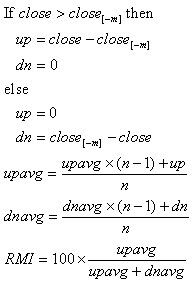
The Relative Strength Index (RSI) was developed by J. Welles Wilder and was first introduced in his article in the June, 1978 issue of Commodities magazine, now known as Futures magazine, and is detailed in his book New Concepts In Technical Trading Systems.
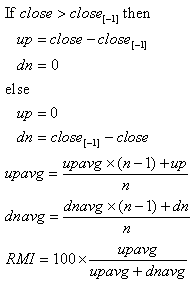
High r-squared values indicate a strong correlation, and an indication of a trend. An r-squared value above the critical value listed below indicates a positive correlation between the price and the linear regression line with 95% confidence.
n r-squared
5 .77
10 .40
14 .27
20 .20
25 .16
30 .13
50 .08
60 .06
120 .03
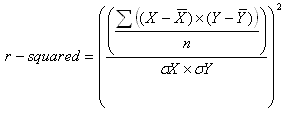
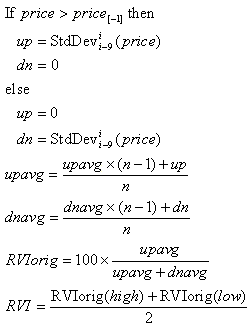
The RVI is a volatility indicator. It was developed as a compliment to and a confirmation of momentum based indicators. When used to confirm other signals, only buy when the RVI is over 50 and only sell when the RVI is under 50. If a signal is ignored, buy when the RVI is over 60 and sell when the RVI is under 40. Exit a long position if the RVI drops below 40 and exit a short position when the RVI rises above 60.
Also see the RVI Original.
The Relative Volatility Index was developed by Donald Dorsey and was originally introduced in his article in the June, 1993 issue of Technical Analysis of Stocks & Commodities magazine, and later revised in his article in the September, 1995 issue of the same magazine.
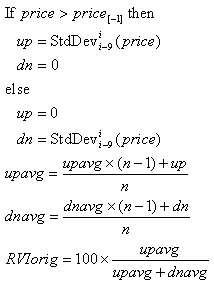
The short-term (2 to 7 periods) RWI is an overbought/oversold indicator, while the long-term (8 to 64 periods) RWI is a trend indicator. An issue is trending higher if the RWI of the highs is greater than 1, while a downtrend is indicated if the RWI of the lows is greater than 1. A buy signal is generated when the long-term RWI of the highs is greater than 1 and the short-term RWI of the lows rises above 1. A sell signal is generated when the long-term RWI of the lows is greater than 1 and the short-term RWI of the highs rises above 1.
The Random Walk Index was developed by Michael Poulos and is described in his article in the February, 1991 issue of Technical Analysis of Stocks & Commodities magazine.

See also Exponential MA, Least Squares MA, Triangular MA, Weighted MA, Welles MA, Variable MA, Volume Adjusted MA, Zero Lag Exponential MA, DEMA, TEMA and T3. Stochastic Momentum Index (SMI): The Stochastic Momentum Index (SMI) is based on the Stochastic Oscillator. The difference is that the Stochastic Oscillator calculates where the close is relative to the high/low range, while the SMI calculates where the close is relative to the midpoint of the high/low range. The values of the SMI range from +100 to -100. When the close is greater than the midpoint, the SMI is above zero, when the close is less than than the midpoint, the SMI is below zero.
The SMI is interpreted the same way as the Stochastic Oscillator. Extreme high/low SMI values indicate overbought/oversold conditions. A buy signal is generated when the SMI rises above -50, or when it crosses above the signal line. A sell signal is generated when the SMI falls below +50, or when it crosses below the signal line. Also look for divergence with the price to signal the end of a trend or indicate a false trend.
The Stochastic Momentum Index was developed by William Blau and was introduced in his article in the January, 1993 issue of Technical Analysis of Stocks & Commodities magazine.

When the bands are close together, it means that there is a low standard error, which means that the price is in a trend. When the bands are farther apart, then the price is not trending. When the price is in a trend and the bands are close together, look for the bands to widen to signal the end of the trend.
Standard Error Bands were developed by Jon Anderson.


Also see the General Stochastic Calculation.
The Stochastic Indicator was developed by George C. Lane.
Terminology:
- Fast Stochastic Refers to both %K and %D where %K is un-smoothed
- Slow Stochastic Refers to both %K and %D where %K is smoothed
- Raw %K Un-smoothed %K
- Fast %K Un-smoothed %K
- Slow %K Smoothed %K
- Fast %D Moving average of an un-smoothed %K
- Slow %D Moving average of a smoothed %K, in effect: a double smoothed %K. Always refers to a smoothed %K (whether or not the %K itself is smoothed).


The Stochastic RSI can be interpreted several ways. Overbought/oversold conditions are indicated when the StochRSI crosses above .20 / below .80. A buy signal is generated when the StochRSI moves from oversold to above the midpoint (.50). A sell signal is generated when the StochRSI moves from overbought to below the midpoint. Also look for divergence with the price to indicate the end of a trend.
See also Stochastic, Stochastic Oscillator and RSI.
The Stochastic RSI was developed by Tushar S. Chande and Stanley Kroll and is described in their 1994 book, The New Technical Trader.

It is important to use the correct limit move for the commodity you are analyzing (e.g. $3.00 for T-Bonds, $0.04 for Heating Oil, etc). For a stock, limit move should be a large number, such as $10,000.
The Swing Index was developed by J. Welles Wilder and is described in his 1978 book New Concepts In Technical Trading Systems.
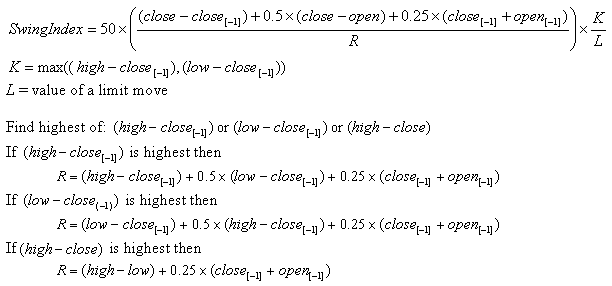
The T3 triple-smoothes the data series by calling the GD three times. You can pass any value for tcount to the T3 function. For instance, a tcountof 4 would be quadruple-smoothed, in effect a T4. A tcount of 1 would be a single-smoothed GD.
Any data series can be smoothed with the T3, including price or the output of another indicator.
See also Exponential Moving Average, DEMA and TEMA.
The T3 was developed by Tim Tillson and was described in his January, 1998 article in Technical Analysis of Stocks & Commodities magazine.

The TEMA was developed by Patrick Mulloy and is described in his article in the January, 1994 issue of Technical Analysis of Stocks & Commodities magazine.
See also Exponential Moving Average, DEMA and T3.

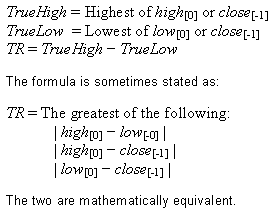
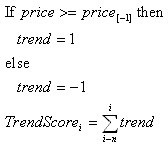
The Triangular Moving Average is mathematically equivalent to a Simple Moving Average of a Simple Moving Average.
See also Exponential MA, Least Squares MA, Simple MA, Weighted MA, Welles MA, Variable MA, Volume Adjusted MA, Zero Lag Exponential MA, DEMA, TEMA and T3.

The TRIX was developed by Jack K. Hutson, publisher of Technical Analysis of Stocks & Commodities magazine, and was introduced in Volume 1, Number 5 of that magazine.

The True Strength Index was developed by William Blau and is described in his 1995 book Momentum, Direction, and Divergence.

See also Average Price, Median Price and Weighted Close.

The Ultimate Oscillator was developed by Larry Williams and was introduced in his article in the April, 1985 issue of Technical Analysis of Stocks & Commodities magazine.


Almost any measure of volatility can be used in calculating the Variable Moving Average, however, most implementations use a 9 period Chande Momentum Oscillator (CMO).
The Variable Moving Average is also known as the VIDYA Indicator.
The Variable Moving Average was developed by Tushar S. Chande and first presented in his March, 1992 article in Technical Analysis of Stocks & Commodities magazine, in which a standard deviation was used as the Volatility Index. In his October, 1995 article in the same magazine, Chande modified the VIDYA to use his own Chande Momentum Oscillator (CMO) as the Volatility Index.
See also Exponential MA, Least Squares MA, Simple MA, Triangular MA, Weighted MA, Welles MA, Volume Adjusted MA, Zero Lag Exponential MA, DEMA, TEMA and T3.
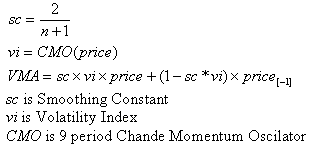
The Vertical Horizontal Filter was developed by Adam White.

The VIDYA is also known as the Variable Moving Average.
The VIDYA was developed by Tushar S. Chande and first presented in his March, 1992 article in Technical Analysis of Stocks & Commodities magazine, in which a standard deviation was used as the Volatility Index. In his October, 1995 article in the same magazine, Chande modified the VIDYA to use his own Chande Momentum Oscillator (CMO) as the Volatility Index.
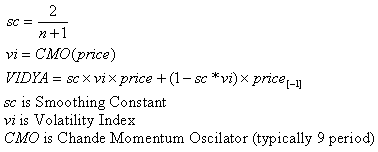
See also Exponential MA, Least Squares MA, Simple MA, Triangular MA, Weighted MA, Welles MA, Variable MA, Zero Lag Exponential MA, DEMA, TEMA and T3.

See also Average Price, Median Price and Typical Price.

See also Exponential MA, Least Squares MA, Simple MA, Triangular MA, Welles MA, Variable MA, Volume Adjusted MA, Zero Lag Exponential MA, DEMA, TEMA and T3.

See also Exponential MA, Least Squares MA, Simple MA, Triangular MA, Weighted MA, Variable MA, Volume Adjusted MA, Zero Lag Exponential MA, DEMA, TEMA and T3.

See also Moving Sum.

ARC - the Average True Range (ATR) times a constant.\r\nSIC - SIgnificant Close, the extreme favorable close price reached while in the trade.\r\nStop And Reverse point, a point defined by the distance between the ARC and SIC. The point at which a trade should be made close the current position and open a new position in the opposite direction. This occurs when the price breaks above/below the SAR.
The Volatility System was developed by J. Welles Wilder and is described in his 1978 book New Concepts In Technical Trading Systems.
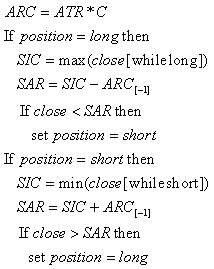
The Williams Accumulation/Distribution Indicator is also know as the Williams AD. It was developed by Larry Williams.
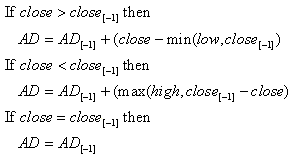
The %R indicator was developed by Larry Williams.

See also Exponential MA, Least Squares MA, Simple MA, Triangular MA, Weighted MA, Welles MA, Variable MA, Volume Adjusted MA, DEMA, TEMA and T3.


